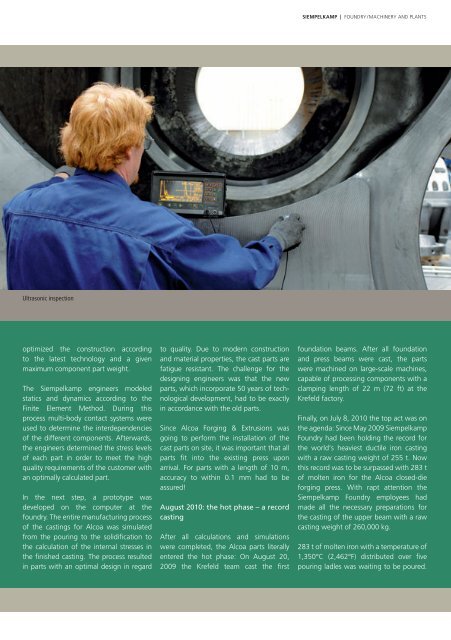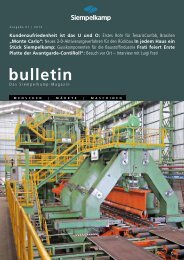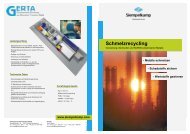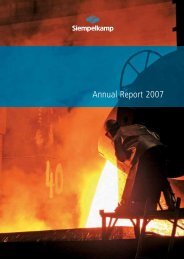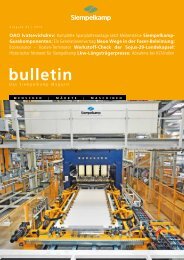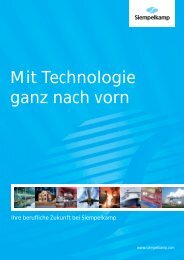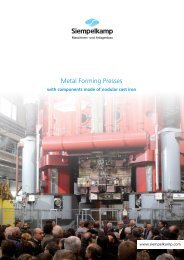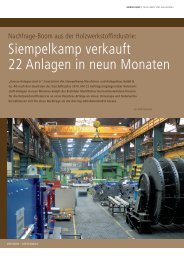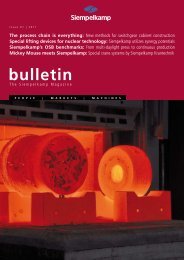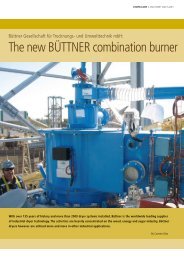Bulletin 2/2010 - Siempelkamp NIS
Bulletin 2/2010 - Siempelkamp NIS
Bulletin 2/2010 - Siempelkamp NIS
Create successful ePaper yourself
Turn your PDF publications into a flip-book with our unique Google optimized e-Paper software.
Ultrasonic inspection<br />
optimized the construction according<br />
to the latest technology and a given<br />
maximum component part weight.<br />
The <strong>Siempelkamp</strong> engineers modeled<br />
statics and dynamics according to the<br />
Finite Element Method. During this<br />
process multi-body contact systems were<br />
used to determine the interdependencies<br />
of the different components. Afterwards,<br />
the engineers determined the stress levels<br />
of each part in order to meet the high<br />
quality requirements of the customer with<br />
an optimally calculated part.<br />
In the next step, a prototype was<br />
developed on the computer at the<br />
foundry. The entire manufacturing process<br />
of the castings for Alcoa was simulated<br />
from the pouring to the solidifi cation to<br />
the calculation of the internal stresses in<br />
the fi nished casting. The process resulted<br />
in parts with an optimal design in regard<br />
to quality. Due to modern construction<br />
and material properties, the cast parts are<br />
fatigue resistant. The challenge for the<br />
designing engineers was that the new<br />
parts, which incorporate 50 years of technological<br />
development, had to be exactly<br />
in accordance with the old parts.<br />
Since Alcoa Forging & Extrusions was<br />
going to perform the installation of the<br />
cast parts on site, it was important that all<br />
parts fi t into the existing press upon<br />
arrival. For parts with a length of 10 m,<br />
accuracy to within 0.1 mm had to be<br />
assured!<br />
August <strong>2010</strong>: the hot phase – a record<br />
casting<br />
After all calculations and simulations<br />
were completed, the Alcoa parts literally<br />
entered the hot phase: On August 20,<br />
2009 the Krefeld team cast the fi rst<br />
SIEMPELKAMP | FOUNDRY/MACHINERY AND PLANTS<br />
foundation beams. After all foundation<br />
and press beams were cast, the parts<br />
were machined on large-scale machines,<br />
capable of processing components with a<br />
clamping length of 22 m (72 ft) at the<br />
Krefeld factory.<br />
Finally, on July 8, <strong>2010</strong> the top act was on<br />
the agenda: Since May 2009 <strong>Siempelkamp</strong><br />
Foundry had been holding the record for<br />
the world‘s heaviest ductile iron casting<br />
with a raw casting weight of 255 t. Now<br />
this record was to be surpassed with 283 t<br />
of molten iron for the Alcoa closed-die<br />
forging press. With rapt attention the<br />
<strong>Siempelkamp</strong> Foundry employees had<br />
made all the necessary preparations for<br />
the casting of the upper beam with a raw<br />
casting weight of 260,000 kg.<br />
283 t of molten iron with a temperature of<br />
1,350°C (2,462°F) distributed over fi ve<br />
pouring ladles was waiting to be poured.


